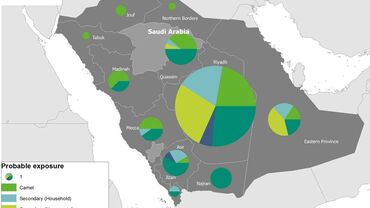Epidemiological update: MERS-CoV case imported to Turkey, 21 October 2014
On 18 October 2014, the Ministry of Health Turkey reported that a Turkish citizen working in Saudi Arabia died on 11 October 2014, ten days after onset of a confirmed MERS-CoV infection.
On 18 October 2014, the Ministry of Health Turkey reported that a Turkish citizen working in Saudi Arabia died on 11 October 2014, ten days after onset of a confirmed MERS-CoV infection. The case returned to Turkey on 10 October 2014. It is assumed that the case was symptomatic during the flight. The local health authorities are conducting contact tracing.
Worldwide situation
Overall, 906 laboratory-confirmed cases of MERS-CoV have been reported to the public health authorities worldwide, including 361 deaths as of 21 October 2014 (Figure 1).
Figure 1. Distribution of confirmed cases of MERS-CoV reported as of 21 October 2014, by date and place of probable infection (n=906)

Most of the cases have occurred in the Middle East (Saudi Arabia, United Arab Emirates, Qatar, Jordan, Oman, Kuwait, Egypt, Yemen, Lebanon and Iran) (Table 1).
Between 1 September and 21 October 2014, the health authorities in Saudi Arabia reported 29 cases, 15 of which were in Taif. Twenty-four of them (83%) are male, of which 20 (83%) above 40 years of age. Comorbidities were reported in 20 of the 29 cases. Four cases were reported among healthcare workers. Several cases had contact with animals, including camels, and some reported having drunk camel milk.
On 20 October, the Ministry of Health of Saudi Arabia issued a press release about the implementation of measures to control the cluster of cases in Taif, in particular addressing the dialysis units.
Table 1. Number of confirmed cases and deaths, by country of reporting as of 21 October 2014
Reporting country |
Cases |
Deaths |
Date of onset/reporting for most recent cases |
|---|---|---|---|
Middle East |
|
|
|
Saudi Arabia |
771 |
328 |
21/10/2014 |
United Arab Emirates |
73 |
9 |
11/06/2014 |
Qatar |
8 |
4 |
12/10/2014 |
Jordan |
18 |
5 |
23/05/2014 |
Oman |
2 |
2 |
20/12/2013 |
Kuwait |
3 |
1 |
07/11/2013 |
Egypt |
1 |
0 |
22/04/2014 |
Yemen |
1 |
1 |
17/03/2014 |
Lebanon |
1 |
0 |
22/04/2012 |
Iran |
5 |
2 |
25/06/2014 |
Europe |
|
|
|
Turkey |
1 |
1 |
06/10/2014 |
Austria |
1 |
0 |
29/09/2014 |
United Kingdom |
4 |
3 |
06/02/2013 |
Germany |
2 |
1 |
08/03/2013 |
France |
2 |
1 |
08/05/2013 |
Italy |
1 |
0 |
31/05/2013 |
Greece |
1 |
1 |
08/04/2014 |
Netherlands |
2 |
0 |
05/05/2014 |
Rest of the world |
|
|
|
Tunisia |
3 |
1 |
01/05/2013 |
Algeria |
2 |
1 |
24/05/2014 |
Malaysia |
1 |
1 |
08/04/2014 |
Philippines |
1 |
0 |
11/04/2014 |
United States of America |
2 |
0 |
01/05/2014 |
Total |
906 |
361 |
Geographical distribution
All cases reported outside of the Middle East have had a recent travel history to the Middle East or contact with a case who had travelled from the Middle East (Figure 2).
Figure 2. Geographical distribution of confirmed MERS-CoV cases and place of probable infection, worldwide, as of 21 October 2014 (n=906)

Conclusions
- The incidence of cases in September and October 2014 is slightly higher than in July and August 2014. This pattern was also observed in 2012 and 2013. The majority of MERS-CoV cases are still being reported from the Arabian Peninsula, specifically from Saudi Arabia, and all cases have epidemiological links to the outbreak epicentre.
- According to the pattern observed in 2012 and 2013, more cases could be observed in the coming weeks.
- The latest importation to the EU (Austria) and to Turkey are not unexpected and do not indicate a significant change in the epidemiology of the disease. Importation of MERS-CoV cases to the EU remains possible. However, the risk of sustained human-to-human transmission remains very low in Europe.






